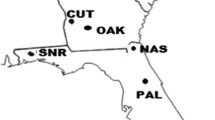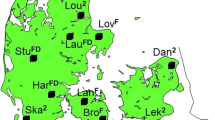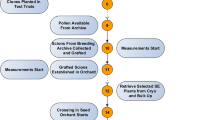Abstract
Four selection methods, individual selection (IS), family selection (FS), family plus within-family selection (FWFS) and combined selection (CS), were used to estimate genetic gain [E(g)] for stem volume and gene diversity (GD) for ten theoretical selection intensities in a 108-family, 12-year-old red pine seedling seed orchard. Estimated genetic gain for stem volume ranged from 4.6% to 11.8% across all selection methods and intensities with CS consistently having the highest gains and FS the lowest for any given selection intensity. Genetic diversity ranged from 0.9797 to 0.9954 across all selection methods and intensities. Individual selection was the best selection method for retaining GD, especially at the higher selection intensities, while FWFS was more efficient at the lowest selection intensity. An optimization point, which maximized E(g) and GD relative to each other, was calculated for each selection method. In all cases the optimization point indicated that both E(g) and GD would be favorably high when optimized relative to each other. The implications for volume gain, genetic diversity and potential inbreeding in red pine, a species with inherently low levels of genetic variation, are discussed.



Similar content being viewed by others
References
Adams GW, Morgenstern EK (1991) Multiple-trait selection in jack pine. Can J For Res 21:439–445
Adams WT, White TL, Hodge GR, Powell GL (1994) Genetic parameters for bole volume in longleaf pine: large sample estimates and influences of test characteristics. Sil Genet 43:357–366
Becker WA (1984) Manual of quantitative genetics, 4th edn. Academic, Pullman
Berg EE, Hamrick JL (1997) Quantification of genetic diversity at allozyme loci. Can J For Res 27:415–424
Burns RM, Honkala BH (1990) Silvics of North America, vol. 1. Conifers. Agriculture Handbook 654. U.S. Department of Agriculture, Forest Service, Washington, D.C.
Canavera DS (1975) Variation among the offspring of selected lower Michigan jack pines. Sil Genet 24:12–15
Carter KK, Adams GW, Greenwood MS, Nitschke P (1990) Early family selection in jack pine. Can J For Res 20:285–291
Cotterill PP (1987) Short note: on estimating heritability according to practical applications. Sil Genet 36:46–48
Cotterill PP, Dean CA (1990) Successful tree breeding with index selection. CSIRO Publ, Victoria, Australia
Dieters MJ, White TL, Hodge GR (1995) Genetic parameter estimates for volume from full-sib tests of slash pine (Pinus elliottii). Can J For Res 25:1397–1408
Ek AR (1985) A formula for the total cubic foot stem volume of small trees in the lake states. North J Appl For 2:3
Falconer DS (1989) Introduction to quantitative genetics, 3rd edn. John Wiley & Sons, New York
Fowler DP (1965) Effects of inbreeding in red pine, Pinus resinosa Ait., II. pollination studies. Silv Genet 14:12–23
Fowler DP, Morris RW (1977) Genetic diversity in red pine: evidence for low genic heterozygosity. Can J For Res 7:343–347
Guries R, Ager A (1980) Red pine seedling seed orchards: 10 year results. Forestry Research Notes, Department of Forestry, University of Wisconsin, No. 242
Hamrick JL, Godt MJW (1989) Allozyme diversity in plant species. In: Brown AHD, Clegg MT, Kahler AL, Weir BS (eds) Plant population genetics, breeding and genetic resources. Sinauer Press, Sunderland, Mass., pp 43–63
Hodge GR, Dvorak WS (1999) Genetic parameters and provanance variation of Pinus tecumumanii in 78 international trials. For Genet 6:157–180
Kang KS, Bila AD, Lindgren D, Choi WY (2001) Predicted drop in gene diversity over generations in the population where the fertility varies among individuals. Silv Genet 50:200–205
Klieve HM, Kinghorn BP, Barwick SA (1994) The joint regulation of genetic gain and inbreeding under mate selection. J Anim Breed Genet 111:81–88
Ledig FT, Whitmore JL (1981) Heritability and genetic correlations for volume, foxtails, and other characteristics of Caribbean pine in Puerto Rico. Silv Genet 30:88–92
Lester DT (1976) Height growth of red pine families in seedling seed orchards 6 years after planting. Forestry Research Notes, Department of Forestry, University of Wisconsin. No. 196
Lindgren D, Matheson AC (1986) An algorithm for increasing the genetic quality of seed from seed orchards by using the better clones in higher proportions. Silv Genet 35:173–177
Lindgren D, Mullin TJ (1997) Balancing gain and relatedness in selection. Silv Genet 46:124–129
Lindgren D, Libby WS, Bondesson FL (1989) Deployment to plantations of numbers and proportions of clones with special emphasis on maximizing gain at a constant level of diversity. Theor Appl Genet 77:825–831
Lindgren D, Gea L, Jefferson P (1996) Loss of genetic diversity monitored by status number. Silv Genet 45:52–59
Magnussen S, Yeatman CW (1990) Predictions of genetic gain from various selection methods in open pollinated Pinus banksiana progeny trials. Silv Genet 39:140–153
Morris DM, Parker WH, Seabrook R (1992) Some considerations when selecting young jack pine families using growth and form traits. Can J For Res 22:429–425
Moura VPG, Dvorak WS, Hodge GR (1998) Provanance and family variation of Pinus oocarpa grown in the Brazilian cerrado. For Ecol Manage 109:315–322
Quinton M, Smith C (1995) Comparison of evaluation-selection systems for maximizing genetic response at the same level of inbreeding. J Anim Sci 73:2208–2212
Rosvall O, Andersson EW (1999) Group-merit selection compared to conventional restricted selection for trade-offs between genetic gain and diversity. For Genet 6:1–14
SAS Institute (1999) The SAS system, version 8. SAS Institute, Cary, N.C.
SPSS (2001) sigmaplot version 7.0. SPSS, Chicago, Ill
Wei RP, Lindgren D, Yeh FC (1997) Expected gain and status number following restricted individual and combined-index selection. Genome 40:1–8
Wilson SP (1974) An experimental comparison of individual, family, and combination selection. Genetics 76:823–836
Zobel B, Talbert J (1984) Applied forest tree improvement. John Wiley & Sons, New York
Acknowledgements
The authors would like to thank D. Gilmore, S. Hokanson, C. Mohn and two anonymous reviewers for comments on earlier versions of the manuscript; P. Anderson for assistance with figures; M. Pannkuk for field measurements. This work was supported in part by the Minnesota Tree Improvement Cooperative, Minnesota Agricultural Experiment Station and the College of Natural Resources at the University of Minnesota.
Author information
Authors and Affiliations
Corresponding author
Additional information
Communicated by D.B. Neale
Rights and permissions
About this article
Cite this article
David, A., Pike, C. & Stine, R. Comparison of selection methods for optimizing genetic gain and gene diversity in a red pine (Pinus resinosa Ait.) seedling seed orchard. Theor Appl Genet 107, 843–849 (2003). https://doi.org/10.1007/s00122-003-1330-0
Received:
Accepted:
Published:
Issue Date:
DOI: https://doi.org/10.1007/s00122-003-1330-0




